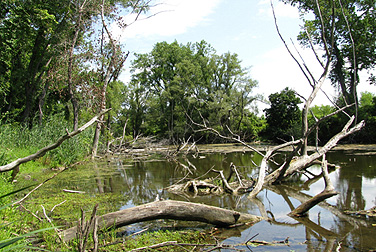News
Students develop plan for wetlands

UB graduate students and researchers have developed a restoration plan for this West Seneca wetland. Photo: BERNADETTE CLABEAUX
An important 14-acre wetland and wildlife habitat that has been donated to the Town of West Seneca is a unique and valuable ecosystem in an urban setting that should be preserved, according to UB graduate students and researchers who have developed a restoration plan for it.
“This is a rare site for Western New York in the heavily industrialized Buffalo River watershed,” says David Blersch, research scientist and coordinator of UB’s Ecosystem Restoration through Interdisciplinary Exchange (ERIE) program.
The stewardship plan for the West Seneca site was developed as part of a graduate course at UB called “Ecosystem Restoration Practicum,” required for students in the university’s National Science Foundation-funded ERIE program. ERIE is training a new generation of researchers in environmental and ecosystem restoration using the ecological treasures of Western New York and the Great Lakes basin as a "living laboratory;” it’s one of few programs in the nation that trains students to take an interdisciplinary approach to restoring natural ecosystems by drawing on fields ranging from science and engineering to policy, ethics and cultural considerations.
Blersch explains that the site, adjacent to Buffalo Creek off Clinton Road, is an “oxbow wetland,” a natural feature created when part of the old river channel is cut off from the main channel by high flow events. What remains is a new, curved body of water situated next to, but separate from, the main river and which, over time, becomes a wetland.
Wetlands like these create a rich habitat for a diverse mix of species, Blersch says, adding that they also provide a critical, albeit often underappreciated, service to the surrounding human communities.
“Think of wetlands as nature’s kidneys,” he says. “Because their water moves slowly, wetlands filter out a lot of pollutants from runoff that otherwise could pollute larger bodies of water. By absorbing pollutants, wetlands can be thought of as buffering surrounding areas from pollution runoff from excessive rainfall. They are doing—for free—what storm sewers and treatment facilities would cost a couple of million dollars to do, all while providing natural habitat, too.”
Unlike most locations along the lower Buffalo River watershed, this site was never developed, despite its location on the outskirts of a metropolitan area, he says.
In a field study of the ecological health of the site, Blersch and six UB students found that it is home to an interesting mix of diverse, native species, especially birds such as woodpeckers, migratory birds and water birds like green herons and night herons.
They also found that it would make an ideal site for frogs and toads, species that are rapidly losing suitable habitats everywhere.
“Amphibian populations are crashing globally,” says Blersch “and we don’t know exactly why. Because this West Seneca site is a wetland not connected to the river, there is little danger of fish eating frog eggs or young. This and other factors make it an excellent breeding ground for amphibians.”
The UB study suggests how simple restoration techniques could help improve the oxbow site as a habitat for amphibians, Blersch says, including removing blockages to improve water quality and retaining dead wood for habitat value.
In collaboration with Buffalo-Niagara Riverkeeper, the UB trainees conducted extensive biological and engineering assessments at the site and developed other ways to enhance existing habitats, such as how to manage invasive species and encourage native ones; they also explored ways to involve the community and owners of adjacent properties as stewards of the site. They gave presentations to site stakeholders and developed a comprehensive restoration and stewardship plan, including plans for a research field camp program with Canisius High School, which owns adjacent property.
As this practicum demonstrates, says Blersch, nearby lakes, rivers, creeks and shorelines are benefiting from the ERIE program and its efforts involving UB students in restoring ecosystems in Western New York.
ERIE involves the collaboration of students and scholars from the Department of Civil, Structural and Environmental Engineering in the School of Engineering and Applied Sciences, and the departments of American Studies, Biological Sciences, Chemistry, Geography, Geology and Philosophy, all in the College of Arts and Sciences.
For more information about ERIE, contact Blersch at dblersch@buffalo.edu or 645-4001.

Reader Comments